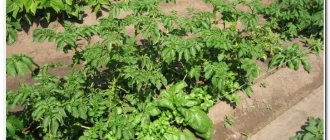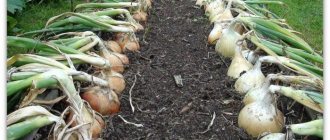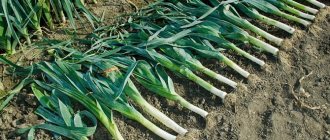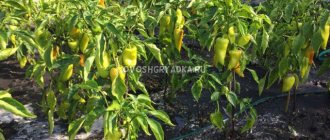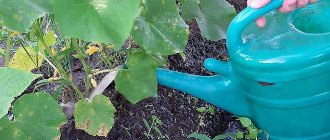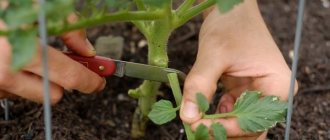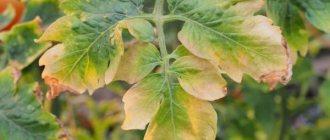Do I need to pick off the bottom leaves of cabbage?
With normal development of cabbage heads, there is no need to remove the lower leaves . They contain a large amount of vitamin C, so the absence of greens will lead to depletion of the crop and a lack of useful components. In addition, the heads of cabbage will lose their natural protection from external negative influences. Why remove leaves and is it worth the risk? These are logical questions that arise for many gardeners.
This need arises in certain cases and, on the contrary, has a positive effect on productivity.
In what cases is removal required?
There are several cases in which forcing cabbage to head is beneficial. To properly grow the crop, you should familiarize yourself with each case in detail.
Preventing rot
Sediment and water often accumulate on the surface of the lower leaves after irrigating the beds, which can trigger the process of rotting. To prevent rot from spreading to the heads of cabbage, gardeners cut off excess greenery.
When cracking heads of cabbage
Early varieties of cabbage often begin to crack as they grow along with the leaves. If you cut them off, the development of the head of cabbage will slow down slightly and it will not crack. However, this method is not the most effective, and there is an alternative option to solve the problem. To keep the heads of cabbage intact, you can slightly pull them out of the soil and turn them to the side. This process also slows growth and helps maintain integrity.
Extending the life of early varieties of cabbage
Since the absence of lower leaves leads to a delay in the development of heads of cabbage, this helps to keep them in the garden for a longer period of time. If there is no possibility of processing or suitable storage conditions have not yet been created, it is recommended to extend the life of the vegetable by artificial means.
See also
The best way to treat Chinese cabbage to combat pests and diseases
Read
When affected by vascular bacteriosis
You can notice signs of damage by vascular bacteriosis when examining the culture. The plants will begin to turn yellow from the bottom, and darkening and black spots will form on the surface of the leaf blades. To stop the spread of the disease, you need not only to pick off the greenery, but also to completely get rid of the affected planting. If the plant is not detected and destroyed in a timely manner, the disease will spread to neighboring crops.
Varieties
To achieve a rich harvest and uninterrupted supply of vegetables to the table before frost, special attention should be paid to the selection of varieties.
For regions with short rather than hot summers (Leningrad region), it is better to use undemanding early ripening varieties, namely:
- "Snowflake" is an early ripening variety with an interval of 100-115 days from vigorous initiation to industrial ripening. The plant is planted in the soil in May. The head is thin, undulating, flat, white and can weigh up to 2 kg. It is characterized by high yield stability and excellent taste characteristics. This variety is resistant to many diseases.
- “Guarantee” is a view of early maturation. In greenhouse conditions, fruit ripening occurs within 16-20 days. The head is cream or white in color, weighs up to one kg, and has good resistance to cracking.
- “Home” is one of the famous old varieties. It is characterized by early repayment and high yield. Harvesting can begin on the 95th day after germination. The heads are narrow, white and well preserved.
In the middle zone of Russia and the Moscow region, it is recommended to grow cauliflower of the following types:
- "Snow globe" is an early ripening. Vegetables are characterized by hard, flat, round heads weighing up to 850 grams. If you take good care of the plant, you will get fruits weighing about 1.3 kg.
- “Flora Blanca is a medium-ripe cauliflower, high-yielding (25 tons per hectare) with good taste characteristics.
- Express" - the characteristics of this variety are a short ripening period and low fruit weight (350-450 g).
Today, gardeners grow cauliflower even in the harsh climatic conditions of the Urals and Siberia. Common varieties common in these regions are:
- early ripening - “Movir 74”, “Gribovskaya 1355”, “White Castle”;
- midlife rockets, bravo, pioneer, fargo;
- Late matured - Skywalker F, Two Sisters.
The variety of cauliflower is very large and varied. When choosing the right type of cabbage, it is necessary to take into account the climatic characteristics of the regions, which affect the timing of sowing, growing season and harvesting.
Saving plantings from cutworms and cabbage flies
Harmful insects, including cutworms and cabbage flies, often take up residence in the lower part of the crop. Pupae of pests remain in the soil for the winter and, with the onset of spring warming, move to the foliage, where they subsequently begin to lay eggs.
Having discovered parasite eggs on the surface of leaf blades, it is necessary to immediately remove and destroy the affected elements.
Pruning does not always help completely get rid of pests. To destroy the cutworm and cabbage fly, it is necessary to additionally spray with protective insecticidal agents.
Land preparation
A site for planting cauliflower is selected and prepared in the fall. Cabbage grows well in sandy and loamy soils.
The site should be located on the sunny side of the garden, and the acidity of the soil should be neutral (= 6.7-7.4). Onions, potatoes, garlic, legumes and carrots are considered good precursors for growing vegetable crops.
And after tomatoes, all types of cabbage, radishes, turnips, turnips, cauliflower are planted only after three to four years. During the autumn excavation work on the installation of the sidewalk, 7-9 kg per 1 square meter is added. m of manure. Along with organic matter, it is advisable to add 30-50 g/m² of superphosphate to the soil.
In the spring, the soil is additionally fertilized with wood ash (1 cup per square meter), nitrophos (30 g per square meter), potassium salt, ammonium nitrate and again pulled out with the shameful dissolution of lumps.
Pros and cons of removing cabbage leaves
When caring for cabbage, you should weigh the advantages and disadvantages of removing the lower leaves. The advantages include the following:
- if the leaf blades are damaged, their removal will protect the head of cabbage and prevent the development of diseases;
- Performing the procedure before harvesting allows you to increase the weight of the heads of cabbage.
Among the negative aspects of pruning are the following:
- covering leaves are used as a temperature and moisture regulator;
- greens are used as a protective element and protect the heads of cabbage from external influences;
- pruning disrupts the natural development process, which can negatively affect the maturation process.
Selecting quality seeds
When growing cabbage crops, many prefer to follow the path of least resistance, namely, buy ready-made seedlings. But experienced gardeners know that if you do everything yourself, the results will be better. The choice of quality seed is the most important prerequisite for a good harvest.
Points to consider when choosing seeds:
Region. Many varieties are specially developed for growing in a particular climate zone. Cabbage ripens early, mid and late. Buy mid to late ripening and you'll love early ripening in early summer. Purpose of harvesting. For example, one variety is suitable for warm foods, while another is suitable for sour foods.
Advice: Don’t get lost in the variety of varieties; it’s better to buy several types that differ in maturity.
Where is the best place to buy seeds and at what price?
When buying grannies at the market, you risk not getting what you ordered. The human factor is to blame for everything - it’s easy to confuse expensive with cheap, one type with another.
The store will competently advise you, and the seeds will be sorted and packaged at the factory, which will reduce the likelihood of errors. You can also order goods in the online store. In this case, the price will be lower, but the quality will be no worse, and maybe better.
When to remove
It is recommended to carry out the removal procedure in late summer - early autumn. If you detect signs of invasion by harmful insects or disease, it is necessary to prune immediately. It is best to prune in dry weather, starting to remove the greens one by one from the very bottom.
Until the cut heals and the affected area dries out, pruning cannot be continued.
If the head of cabbage is not compacted, it is possible to remove all the lower leaves. This pruning is carried out no earlier than a month before harvesting, which often occurs in mid-September. Within a month, the density of the head of cabbage manages to increase sufficiently.
Rules for cutting the lower leaves of a cabbage rosette
The leaves located at the bottom of the head of cabbage are carefully removed one at a time. After removal, the leaf cut is thoroughly treated with a disinfectant solution to prevent infection of the plant. Then the cut is sprinkled with sifted wood ash.
See also
How often should you water cabbage in open ground, how many times and with what water?
Read
In some cases, it is possible to remove not the entire sheet plate, but only a part. This option is used in cases where there is no special need for pruning, but the greenery interferes with caring for the crop. Removal can also be carried out in case of dense planting, when plants interfere with each other's development.
Obtaining seedlings
To grow cabbage seedlings, you need to prepare the soil by mixing sand, grass and peat in a 1:1:1 ratio. Garden soil and humus are not recommended, as there is a high probability of infection with various diseases.
The soil substrate is disinfected with a saturated solution of potassium permanganate (manganese) or burned in an oven at a temperature of 55-60°C. The substrate is treated with a saturated solution of potassium permanganate (manganese).
Sowing seeds onto seedlings occurs in stages, depending on the time of maturation:
- In the last days of February they sow early maturing, early maturing varieties;
- mid-season sow in mid-March;
- Seeds of late-ripening plants are sown in early April.
Seeds must be prepared before sowing. Before sowing, soak the seed in hot water (45-50°C) for about 15-20 minutes, and then leave it in cold water for one to two minutes. Then the seeds are placed in a prepared solution of microelements and stored for about 12 hours.
After this time, the seeds are rinsed under running water and stored in a cool place for 24 hours. The seeds are then dried and lightly sown.
The air temperature before filming is maintained at 21-25 degrees Celsius, and then drops to ten degrees per week. After 7 days, the temperature rises to 17°C during the day and is maintained at 8-9°C at night. Temperature conditions above 20°C promote early binding of the heads.
Entries are made at 14 days of age. Two weeks before planting the seedlings outdoors, they begin to harden and gradually become accustomed to outdoor weather conditions.
[warning] Please note: Outdoor plants are quickly catching up and surpassing cabbage.
Cabbage plant material can be obtained directly by sowing seeds in open soil in the first ten days of April. The sowing depth in the furrows should be 15-20 mm. The seedbed is watered generously and covered with foil. Seeds are supplied at an ambient temperature of at least +3 - 5 °C. The seeds are treated like seedlings in a greenhouse or at home.
Break off, cut or tear off?
Cabbage gardeners grow plants in different ways. Many people carefully cut off the lower leaves, while others prefer not to waste time and tear off the foliage. It is best to prune using garden shears to avoid damaging the head of cabbage. If it is necessary to remove only part of the damaged sheet, it can be carefully broken off.


